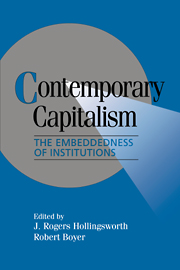Book contents
- Frontmatter
- Contents
- Acknowledgments
- List of Contributors
- Chapter 1 Coordination of Economic Actors and Social Systems of Production
- PART I THE VARIETY OF INSTITUTIONAL ARRANGEMENTS AND THEIR COMPLEMENTARITY IN MODERN ECONOMIES
- Chapter 2 The Variety and Unequal Performance of Really Existing Markets: Farewell to Doctor Pangloss?
- Chapter 3 A Typology of Interorganizational Relationships and Networks
- Chapter 4 Associational Governance in a Globalizing Era: Weathering the Storm
- Chapter 5 Constitutional Orders: Trust Building and Response to Change
- PART II HOW AND WHY DO SOCIAL SYSTEMS OF PRODUCTION CHANGE?
- PART III LEVELS OF SPATIAL COORDINATION AND THE EMBEDDEDNESS OF INSTITUTIONS
- PART IV CONCLUSION
- Index
Chapter 5 - Constitutional Orders: Trust Building and Response to Change
Published online by Cambridge University Press: 05 June 2012
- Frontmatter
- Contents
- Acknowledgments
- List of Contributors
- Chapter 1 Coordination of Economic Actors and Social Systems of Production
- PART I THE VARIETY OF INSTITUTIONAL ARRANGEMENTS AND THEIR COMPLEMENTARITY IN MODERN ECONOMIES
- Chapter 2 The Variety and Unequal Performance of Really Existing Markets: Farewell to Doctor Pangloss?
- Chapter 3 A Typology of Interorganizational Relationships and Networks
- Chapter 4 Associational Governance in a Globalizing Era: Weathering the Storm
- Chapter 5 Constitutional Orders: Trust Building and Response to Change
- PART II HOW AND WHY DO SOCIAL SYSTEMS OF PRODUCTION CHANGE?
- PART III LEVELS OF SPATIAL COORDINATION AND THE EMBEDDEDNESS OF INSTITUTIONS
- PART IV CONCLUSION
- Index
Summary
HIERARCHIES, MARKETS, AND CONSTITUTIONAL ORDERS
To capture what is theoretically distinctive about the commonalties of the new organizational forms in the public and private sectors, and to understand why current theories are blind to this distinctiveness, it is helpful to contrast more familiar governance structures – markets and hierarchies – with a third. I will call this type of governance structure a constitutional order. In introducing this category, however, I do not mean to attempt to supply the missing member of an exhaustive, three-part typology of governance structures. On the contrary, it seems in principle unlikely that the set of these structures is closed. Just as firms operate in markets defined by other firms, governance structures are at bottom strategic responses to competitive environments composed of other governance structures. Under highly restrictive assumptions it is conceivable that the mix of institutional strategies embodying the current governance structures will arrive at a stable equilibrium. But unless the context in which existing governance structures operate is frozen, so long as it is impossible to invent a new strategy that takes advantage of rigidities created by the self-reinforcing mesh of the current ones, equilibrium seems unlikely. In any case, the arguments here for a third governance structure of particular substantive moment are meant to encourage consideration of a class of trust-based coordination mechanisms that parallel the dichotomy of markets and hierarchies. In what follows, I reproduce only as much of the conventional account of this latter dichotomy as needed to create a backdrop for a discussion of an alternative category.
- Type
- Chapter
- Information
- Contemporary CapitalismThe Embeddedness of Institutions, pp. 154 - 188Publisher: Cambridge University PressPrint publication year: 1997
- 23
- Cited by



